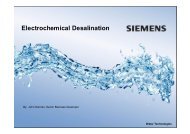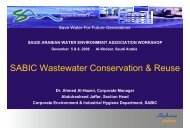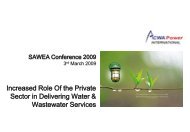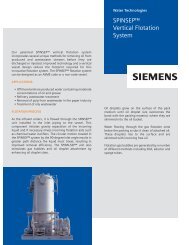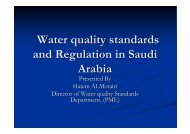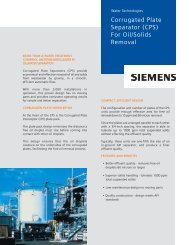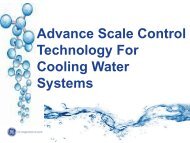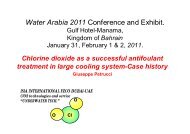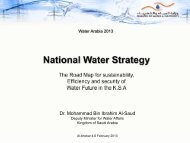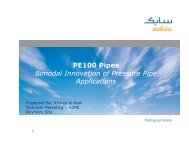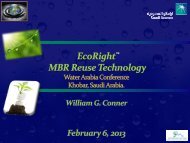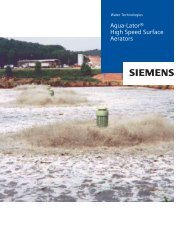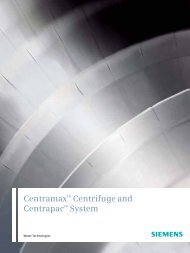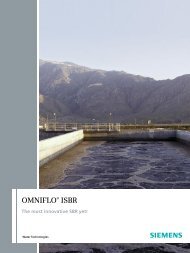Marine Monitoring Surveys for Desalination Plants: A Critical Review
Marine Monitoring Surveys for Desalination Plants: A Critical Review
Marine Monitoring Surveys for Desalination Plants: A Critical Review
You also want an ePaper? Increase the reach of your titles
YUMPU automatically turns print PDFs into web optimized ePapers that Google loves.
<strong>Marine</strong> <strong>Monitoring</strong> <strong>Surveys</strong> <strong>for</strong> <strong>Desalination</strong> <strong>Plants</strong>:<br />
A <strong>Critical</strong> <strong>Review</strong>
Why bother?<br />
• As a regulatory requirement, monitoring <strong>for</strong>ms part of the<br />
modern Environmental Impact Assessment (EIA) process;<br />
• Emphasize the importance of long-term environmental<br />
considerations in the decision-making process;<br />
• Appropriate monitoring can minimize effects of development<br />
proposals as well as these of existing operational facilities;<br />
• When en<strong>for</strong>ced, it will assist in the protection, productivity<br />
and capacity of natural systems and the ecological<br />
processes which maintain their functions.
http://www.tandfonline.com/doi/abs/10.1080/19443994.2012.693700
• Changes in conductivity, temperature, turbidity and the presence of<br />
chemicals may be vital parameters that influence the distribution of<br />
marine species and microbial communities;<br />
• These ‘pollutants’ can be fatal to marine life and can cause a lasting<br />
change in species diversity and abundance in the discharge area;<br />
• Case-to-case basis!
• Shortcomings:<br />
o Limited in scope (i.e., salinity effects only);<br />
o Short-term (often with no baseline or operational monitoring);<br />
o Localized (i.e., no far-range or cumulative effects).<br />
• Appropriate monitoring should (at least):<br />
o Account <strong>for</strong> all the complexity of potential ecosystem responses; &<br />
o Adequately distinguish project effects from natural processes.<br />
?
• Stressor base approach:<br />
o Stressor: [e.g., concentrate discharge];<br />
o Receptor: [e.g., population diversity specific to marine microorganisms];<br />
o Interaction: [stress from elevated salinity].<br />
o<br />
o<br />
This approach does not account <strong>for</strong> other stressor sources;<br />
All stressor sources of a project should be known.<br />
• ‘Effects-based approach’:<br />
o<br />
Measures the ‘accumulated environmental state’ of the ecosystem.
• ‘Stressor-based approach’<br />
• Baseline and operational monitoring in<br />
the project site [Be<strong>for</strong>e – After]<br />
+<br />
• ‘Effects-based’ approach<br />
• Identical studies in an undisturbed control<br />
site [Control – Impact]<br />
= BACI: isolates the impact from natural variability (‘background noise’)<br />
• Appropriate monitoring design will consider:<br />
• Spatial variability (several control sites which adequately represent the<br />
range & habitats found in the impact site; and<br />
• Temporal variability (Several ‘paired sampling’ dates Be<strong>for</strong>e and After<br />
the impact in both the Control & Impact sites).
Seawater<br />
o<br />
Oceanographical parameters<br />
S, T, DO, water currents, etc.<br />
Methods<br />
Stationary buoys<br />
AUVs<br />
ADCPs<br />
o<br />
o<br />
Chemical parameters<br />
Major nutrients;<br />
Priority pollutants<br />
Biological parameters<br />
<strong>Marine</strong> microbial communities<br />
Water samples<br />
Plankton nets;<br />
In situ; &<br />
Flow Cytometry
Seafloor<br />
o<br />
Bathymetry and topography<br />
Image of the seafloor with<br />
topographical features and texture<br />
of the surface is created<br />
Methods<br />
Echosounder<br />
Side-scan sonar<br />
Sub-bottom profilers<br />
o<br />
o<br />
Sediment characteristics<br />
Texture<br />
Pollutants<br />
Biological parameters<br />
Species lists, distribution maps,<br />
quantitative data (e.g. biomass) of<br />
infauna and epifauna species<br />
Grab or core samplers<br />
Grab or core samplers<br />
Underwater surveys<br />
(dives, videos)
<strong>Marine</strong> Life<br />
Methods<br />
o Fish Quantitative survey by trawling:<br />
sufficient replication/coverage<br />
(mobile nature of fish species)<br />
data is still very variable<br />
impacts on seafloor (benthic species)<br />
impact of sampling is large compared to impact area<br />
of a desalination plant?<br />
=> Qualitative surveys more reasonable!<br />
o<br />
o<br />
o<br />
<strong>Marine</strong> reptiles<br />
(turtles, sea snakes,…)<br />
<strong>Marine</strong> mammals<br />
Seabirds<br />
Qualitative surveys with non-invasive methods<br />
due to conservation interest<br />
dives, videos, ship-based counts<br />
qualitative data (species lists)
• Assessing changes in the marine microbial communities at the KAUST RO<br />
outfall, using flow cytometry (FCM) as the primary analyzing tool.<br />
• Objective: To develop microbial indicators <strong>for</strong> improved monitoring and<br />
regulation of discharges from desalination plants using FCM as a rapid<br />
assessment tool <strong>for</strong> fast determination of microbe abundance, diversity and<br />
viability.<br />
• Samples are collected (diving) at a depth of 16m with 5m intervals in a<br />
radius of 25m around the discharge (sterile 15mL Greiner tubes,<br />
transported to the laboratory under cold storage and analyzed on the day of<br />
sampling).<br />
• >50 samples collected; >400 FCM measurements analyzed [1 st campaign<br />
(August 2012) | 2 nd campaign (October 2012)].<br />
• Additional 3 rd campaign & ‘control sites’ sampling is proposed <strong>for</strong> February<br />
18 th & 19 th 2013.
1<br />
2<br />
3<br />
4<br />
5<br />
6<br />
25m
Robin Morelissen (Deltares)<br />
Dr. Sabine Lattemann (KAUST, WDRC)<br />
Prof. Burton Jones (KAUST, Red Sea Research Centre)<br />
• Objective: To develop screening tools <strong>for</strong> operational<br />
aspects (e.g., recirculation) and environmental concerns<br />
(e.g., impacts of brine disposal) of new desalination plants<br />
(or other industrial activities / developments)<br />
Example of web-based screening tool<br />
• will allow <strong>for</strong> a first-order assessment of the proposed<br />
site, project design, construction, etc.<br />
• will combine design criteria of the project with field<br />
observations, environmental knowledge and numerical<br />
modelling.<br />
• will be developed together with and <strong>for</strong> the industry and<br />
will be available <strong>for</strong> their own, independent use (possibly<br />
web-based).
Pre-dictive EIA process:<br />
Predict the likely impacts<br />
Post-dictive EIA process:<br />
Investigate the actual impacts<br />
• Time and cost-intensive to investigate all possible<br />
parameters;<br />
• Non-existence of tailored desalination specific regulations; &<br />
• Lack of robust up-to-date scientific baseline data in order to<br />
support reports on ecological effects, mitigation measures<br />
and appropriate monitoring systems.
• Accuracy of the monitoring results correlate with the ef<strong>for</strong>t<br />
– Temporal and spatial replication (BACIPS) is required to ensure<br />
sufficient statistical robustness of the monitoring analysis<br />
• Scientific journals would reject studies which were carried out with less<br />
that good scientific practice<br />
– Similarly high standards should apply in EIA studies<br />
• Explicit desalination regulation must be generated, adopted and<br />
en<strong>for</strong>ced; &<br />
• <strong>Monitoring</strong> must be based on a holistic coverage of environmental<br />
impacts as part of the decision making process, not only <strong>for</strong> locating and<br />
building new desalination plants, but also <strong>for</strong> monitoring of existing<br />
facilities.
• Prof. Gary Amy<br />
• Dr. Sabine Lattemann<br />
• Dr. Frederik Hammes [Swiss Federal<br />
Institute of Aquatic Science and<br />
Technology (Eawag)]<br />
• Dave Pallett [Coastal and <strong>Marine</strong><br />
Services Core Lab (CMOR)]<br />
Presented by:<br />
Riaan van der Merwe (PhD Candidate)<br />
King Abdullah University of Science and<br />
Technology (KAUST)<br />
Water <strong>Desalination</strong> and Reuse Center<br />
riaan.vandermerwe@kaust.edu.sa
Questions?
• 3 rd campaign (February 2013) in order to confirm preliminary findings;<br />
• Adenosine tri-phosphate (ATP) analysis in order to assess cell viability<br />
(combining it with the 3 rd campaign);<br />
• Detailed assessment of dynamic events influencing the quality of SWRO<br />
concentrate;<br />
Three levels of "events":<br />
1. Daily operation (this becomes the background or standard footprint of<br />
the system)<br />
2. Backwashing events<br />
3. Chlorination (dramatic event once a week)<br />
• Benthic studies;<br />
• Utilizing a mixing zone model to establish revised regulatory mixing zones from<br />
continuous point source discharges.



